大厂算法面试之 leetcode 精讲 21. 树
- 2021 年 12 月 06 日
本文字数:23087 字
阅读完需:约 76 分钟
大厂算法面试之 leetcode 精讲 21.树
视频讲解(高效学习):点击学习
目录:
树这种数据结构包括根节点 root,左右节点,子树中又有父节点,子节点,兄弟节点,没有子节点的成为叶子节点,树分为二叉树和多叉树
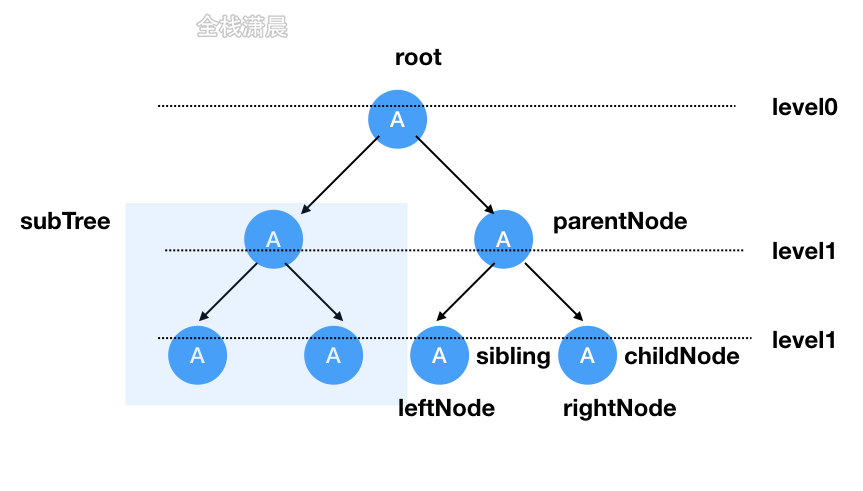
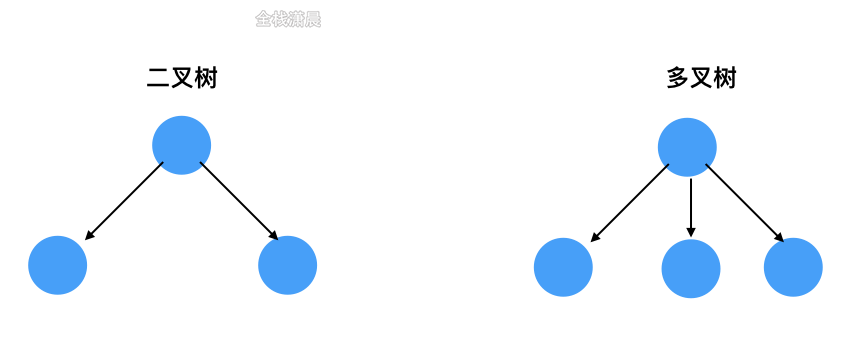
List 就是特殊化的 tree,Tree就是特殊化的Graph
二分搜索树
二分搜索树(英语:Binary Search Tree),也称为 有序二叉树或排序二叉树。满足以下几个条件:
若它的左子树不为空,左子树上所有节点的值都小于它的根节点。
若它的右子树不为空,右子树上所有的节点的值都大于它的根节点。
它的左、右子树也都是二分搜索树。
二分搜索树的优势:不仅可以查找数据,还可以高效的插入、删除数据
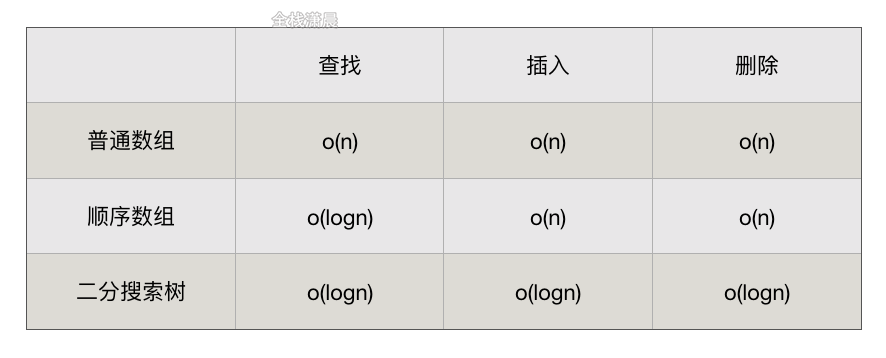
注意二分搜索树不一定是完全二叉树
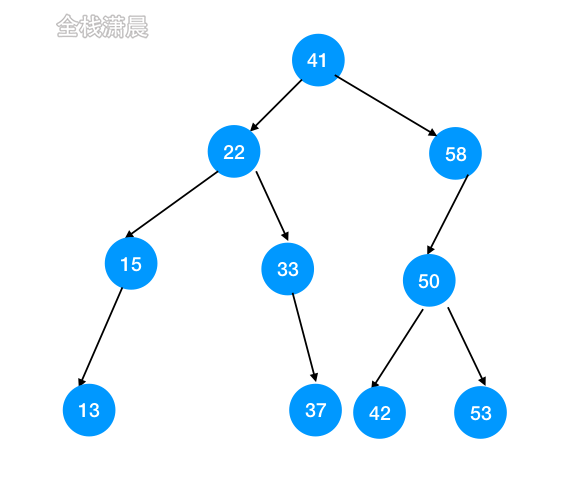
树的遍历
深度优先
广度优先
前序:根-左-右
中序:左-根-右
后序:左-右-根
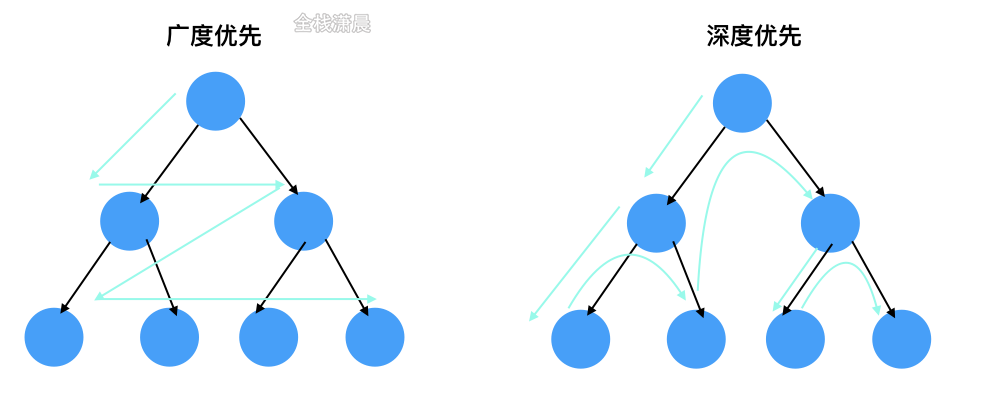
144. 二叉树的前序遍历(easy)
94. 二叉树的中序遍历 (easy)
145. 二叉树的后序遍历 (easy)
方法 1.递归
js:
//时间复杂度O(n),n为节点个树,空间复杂度O(n),即递归的空间开销(树的高度),最坏的情况下树是链表,所以是O(n),平均空间复杂度O(logn)//前序遍历:var preorderTraversal = function(root, res = []) { if (!root) return res; res.push(root.val); preorderTraversal(root.left, res) preorderTraversal(root.right, res) return res;};
//中序遍历:var inorderTraversal = function(root, res = []) { if (!root) return res; inorderTraversal(root.left, res); res.push(root.val); inorderTraversal(root.right, res); return res;};
//后序遍历:var postorderTraversal = function(root, res = []) { if (!root) return res; postorderTraversal(root.left, res); postorderTraversal(root.right, res); res.push(root.val); return res;};
Java:
//时间复杂度O(n),n为节点个树,空间复杂度O(n),即递归的空间开销(树的高度),最坏的情况下树是链表,所以是O(n),平均空间复杂度O(logn)//前序遍历class Solution { ArrayList<Integer> preOrderReverse(TreeNode root) { ArrayList<Integer> result = new ArrayList<Integer>(); preOrder(root, result); return result; }
void preOrder(TreeNode root, ArrayList<Integer> result) { if (root == null) { return; } result.add(root.val); preOrder(root.left, result); preOrder(root.right, result); }}// 中序遍历class Solution { public List<Integer> inorderTraversal(TreeNode root) { List<Integer> res = new ArrayList<>(); inorder(root, res); return res; }
void inorder(TreeNode root, List<Integer> list) { if (root == null) { return; } inorder(root.left, list); list.add(root.val); inorder(root.right, list); }}// 后序遍历class Solution { public List<Integer> postorderTraversal(TreeNode root) { List<Integer> res = new ArrayList<>(); postorder(root, res); return res; }
void postorder(TreeNode root, List<Integer> list) { if (root == null) { return; } postorder(root.left, list); postorder(root.right, list); list.add(root.val); }}
方法 2.迭代
js:
// 时间复杂度O(n),n为节点个树,空间复杂度O(n),显示栈的空间开销
// 前序遍历:中左右// 压栈顺序:右左中var preorderTraversal = function(root, res = []) { const stack = []; if (root) stack.push(root); while(stack.length) { const node = stack.pop(); if(!node) { res.push(stack.pop().val); continue; } if (node.right) stack.push(node.right); // 右 if (node.left) stack.push(node.left); // 左 stack.push(node); // 中 stack.push(null); }; return res;};
// 中序遍历:左中右// 压栈顺序:右中左var inorderTraversal = function(root, res = []) { const stack = []; if (root) stack.push(root); while(stack.length) { const node = stack.pop(); if(!node) { res.push(stack.pop().val); continue; } if (node.right) stack.push(node.right); // 右 stack.push(node); // 中 stack.push(null); if (node.left) stack.push(node.left); // 左 }; return res;};
// 后续遍历:左右中// 压栈顺序:中右左var postorderTraversal = function(root, res = []) { const stack = []; if (root) stack.push(root); while(stack.length) { const node = stack.pop(); if(!node) { res.push(stack.pop().val); continue; } stack.push(node); // 中 stack.push(null); if (node.right) stack.push(node.right); // 右 if (node.left) stack.push(node.left); // 左 }; return res;};
Java:
// 时间复杂度O(n),n为节点个树,空间复杂度O(n),显示栈的空间开销// 前序遍历顺序:中-左-右,入栈顺序:中-右-左class Solution { public List<Integer> preorderTraversal(TreeNode root) { List<Integer> result = new LinkedList<>(); Stack<TreeNode> st = new Stack<>(); if (root != null) st.push(root); while (!st.empty()) { TreeNode node = st.peek(); if (node != null) { st.pop(); if (node.right!=null) st.push(node.right); if (node.left!=null) st.push(node.left); st.push(node); st.push(null); } else { st.pop(); node = st.peek(); st.pop(); result.add(node.val); } } return result; }}
// 中序遍历顺序: 左-中-右 入栈顺序: 左-右class Solution { public List<Integer> inorderTraversal(TreeNode root) { List<Integer> result = new LinkedList<>(); Stack<TreeNode> st = new Stack<>(); if (root != null) st.push(root); while (!st.empty()) { TreeNode node = st.peek(); if (node != null) { st.pop(); if (node.right!=null) st.push(node.right); st.push(node); st.push(null);
if (node.left!=null) st.push(node.left); } else { st.pop(); node = st.peek(); st.pop(); result.add(node.val); } } return result; }}
// 后序遍历顺序 左-右-中 入栈顺序:中-左-右 出栈顺序:中-右-左, 最后翻转结果class Solution {
public List<Integer> postorderTraversal(TreeNode root) { List<Integer> result = new LinkedList<>(); Stack<TreeNode> st = new Stack<>(); if (root != null) st.push(root); while (!st.empty()) { TreeNode node = st.peek(); if (node != null) { st.pop(); st.push(node); st.push(null); if (node.right!=null) st.push(node.right); if (node.left!=null) st.push(node.left); } else { st.pop(); node = st.peek(); st.pop(); result.add(node.val); } } return result; }}
98. 验证二叉搜索树 (medium)
方法 1.递归
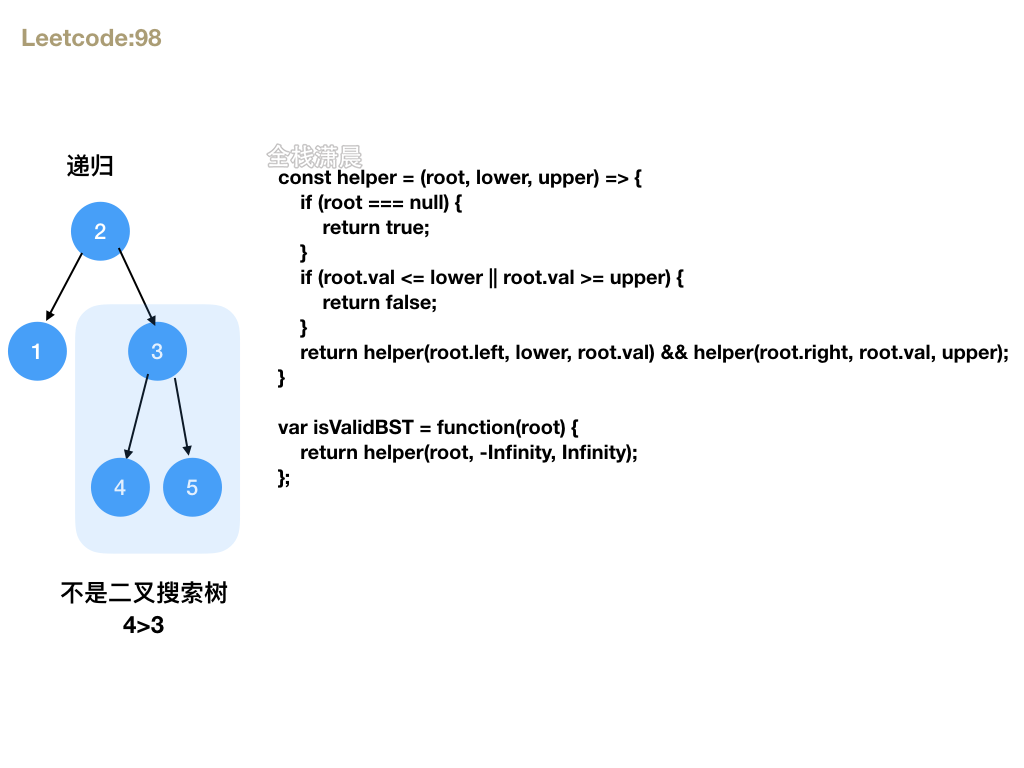
思路:利用二叉搜索树的性质,每个节点都大于它左子树所有节点,小于右子树上所有节点,并且每个节点左右子树不为空,那它的左右子树也是二叉搜索树。我们可以递归验证每个节点的左右子树。
复杂度分析:时间复杂度 :
O(n),n 是二叉树节点的个树。空间复杂度 :O(n),n 是递归的层数,最差的情况下二叉树是一条链,树高 n,也就是总共 n 层
Js:
const helper = (root, lower, upper) => { if (root === null) { return true; } if (root.val <= lower || root.val >= upper) {//终止条件 不满足二叉搜索树的性质 return false; } //递归左右子树 return helper(root.left, lower, root.val) && helper(root.right, root.val, upper);}var isValidBST = function(root) { //定义low=-Infinity,让所有值都大于low //定义upper=Infinity,让所有值都小于upper return helper(root, -Infinity, Infinity);};
Java:
class Solution { public boolean isValidBST(TreeNode root) { return helper(root, Long.MIN_VALUE, Long.MAX_VALUE); }
public boolean helper(TreeNode root, long lower, long upper) { if (root == null) { return true; } if (root.val <= lower || root.val >= upper) { return false; } return helper(root.left, lower, root.val) && helper(root.right, root.val, upper); }}
方法 2:中序遍历
思路:从二叉搜素树的性质可知,中序遍历二叉搜索树,得到的就是升序的数组
复杂度分析:时间复杂度 :
O(n),每个元素被访问一次。空间复杂度 :O(n),中序遍历用栈存储元素,需要额外的O(n)空间
Js:
//非递归版中序遍历var isValidBST = function(root) { let stack = []; let inorder = -Infinity;
while (stack.length || root !== null) { while (root !== null) { stack.push(root); root = root.left; } root = stack.pop(); if (root.val <= inorder) { return false; } inorder = root.val; root = root.right; } return true;};
//递归版中序遍历var isValidBST = function (root) { let arr = []; const buildArr = (root) => { if (root) { buildArr(root.left); arr.push(root.val); buildArr(root.right); } } buildArr(root); for (let i = 1; i < arr.length; ++i) { if (arr[i] <= arr[i - 1]) return false; } return true;};
Java:
class Solution { public boolean isValidBST(TreeNode root) { Deque<TreeNode> stack = new LinkedList<TreeNode>(); double inorder = -Double.MAX_VALUE;
while (!stack.isEmpty() || root != null) { while (root != null) { stack.push(root); root = root.left; } root = stack.pop(); if (root.val <= inorder) { return false; } inorder = root.val; root = root.right; } return true; }}
236. 二叉树的最近公共祖先 (medium)
方法 1.递归
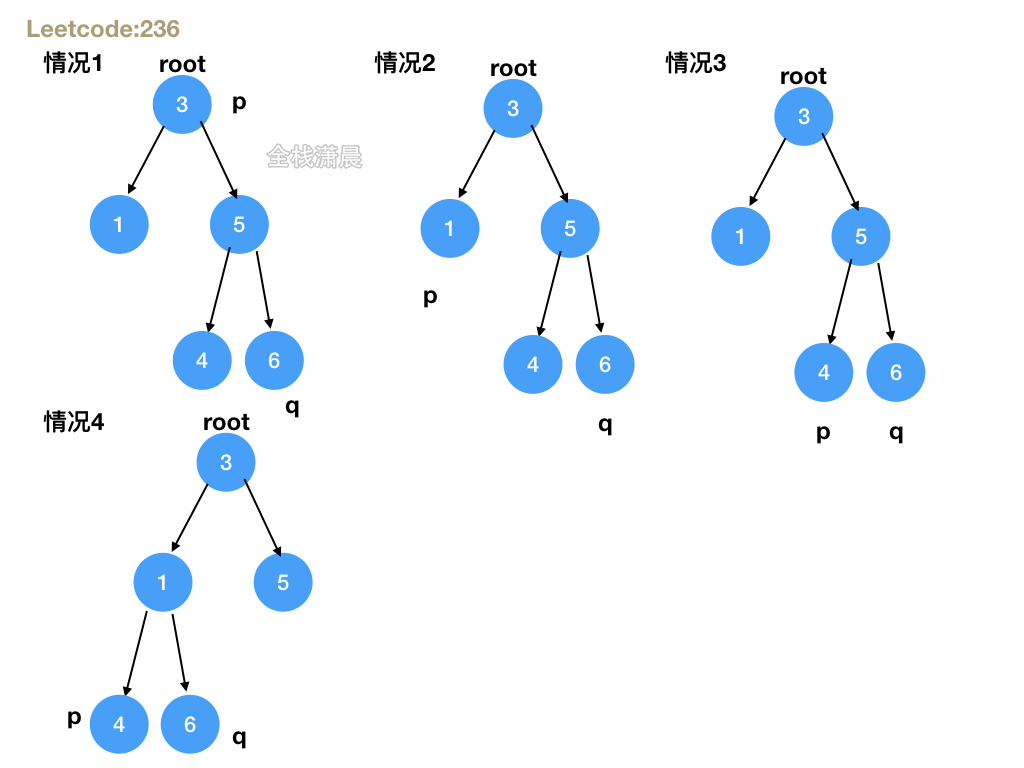
思路:分四种情况,1.root 是 null 或者 root 等于 p 或 q,说明 root 是 p,q 的公共祖先,2.递归左右子树,如果左右子树递归函数返回的都不为空,则 root 就是 p,q 的公共祖先,3.左子树递归函数返回的值为空,则 p,q 都在右子树,4.右子树递归函数返回的值为空,则 p,q 都在左子树
复杂度分析:时间复杂度 :
O(n),n 是二叉树节点的个树,空间复杂度 :O(n),n 是递归的层
Js:
var lowestCommonAncestor = function(root, p, q) { // 1. 确定递归的函数 const travelTree = function(root,p,q) { // 2. 确定递归终止条件 if(root === null || root === p||root === q) { return root; } // 3. 确定递归单层逻辑 let left = travelTree(root.left,p,q); let right = travelTree(root.right,p,q); //如果在某一个节点的左右子树都能找到p和q说明这个节点就是公共祖先 if(left !== null&&right !== null) { return root; } if(left ===null) {//如果左子树没找到就说明p,q都在右子树 return right; } return left;//如果右子树没找到就说明p,q都在左子树 } return travelTree(root,p,q);//递归开始};
Java:
class Solution { public TreeNode lowestCommonAncestor(TreeNode root, TreeNode p, TreeNode q) { return travelTree(root, p, q); } public TreeNode travelTree(TreeNode root, TreeNode p, TreeNode q) { if (root == null || root == p || root == q) { return root; } TreeNode left = travelTree(root.left, p, q); TreeNode right = travelTree(root.right, p, q); if (left != null && right != null) {// 左右子树分别找到了,说明此时的root就是要求的结果 return root; } if (left == null) { return right; } return left; }}
235. 二叉搜索树的最近公共祖先 (easy)
**方法 1:**从二叉搜索树中不断向左右子树寻找 p 或 q 的路径,最后寻找两个路径的第一个相同的节点,时间复杂度O(n),空间复杂度O(n)
方法 2:递归
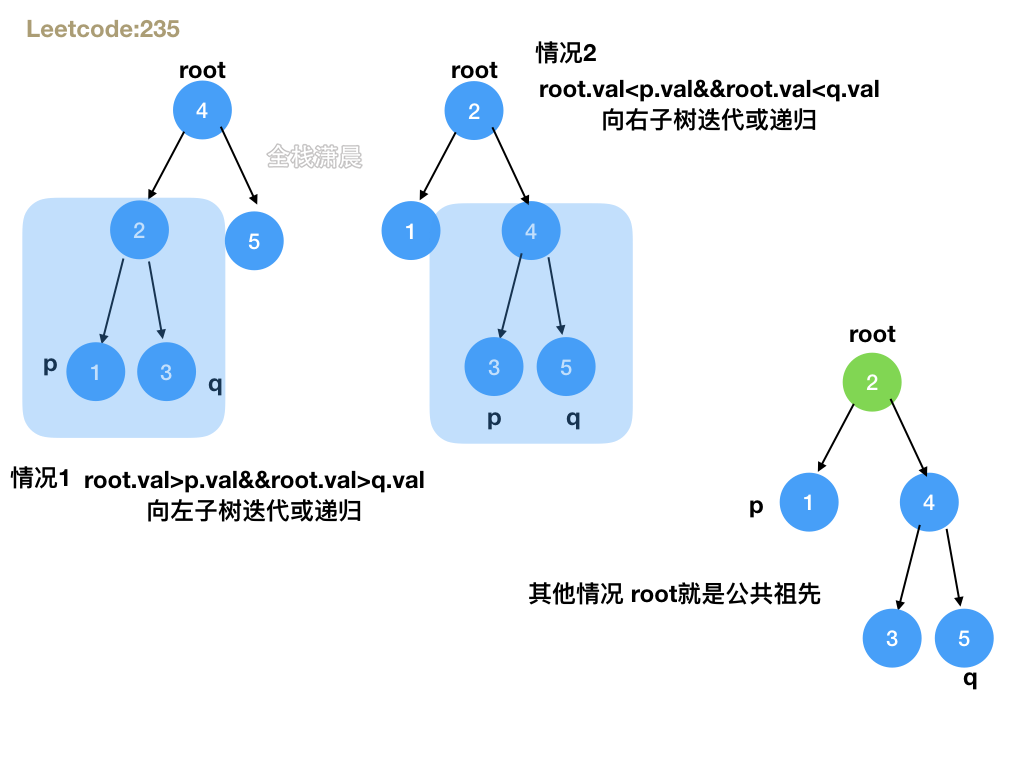
思路:分为三种情况,1.root 节点大于 p 并且大于 q,说明 p 和 q 都在 root 的左子树, 2.root 节点小于 p 并且小于 q,说明 p 和 q 都在 root 的右子树,3.其他情况比如 root 等于 p 或 q,说明 root 就是公共祖先,前两种情况直接递归左右子树,第 3 种情况直接返回 root
复杂度分析:时间复杂度 :
O(n),n 是二叉树节点的个树,空间复杂度 :O(n),n 是递归的层数,最坏情况和 n 相等,此时的树是一个链表
Js:
var lowestCommonAncestor = function(root, p, q) { if(root === null) {//递归终止条件 return root; } //如果root节点大于p并且大于q,说明p和q都在root的左子树 if(root.val>p.val&&root.val>q.val) { let left = lowestCommonAncestor(root.left,p,q); return left !== null&&left; } //如果root节点小于p并且小于q,说明p和q都在root的右子树 if(root.val<p.val&&root.val<q.val) { let right = lowestCommonAncestor(root.right,p,q); return right !== null&&right; } return root;//如果上述条件都不满足说明root就是公共祖先};
Java:
class Solution { public TreeNode lowestCommonAncestor(TreeNode root, TreeNode p, TreeNode q) { if (root.val > p.val && root.val > q.val) return lowestCommonAncestor(root.left, p, q); if (root.val < p.val && root.val < q.val) return lowestCommonAncestor(root.right, p, q); return root; }}
方法 3:迭代

思路:和递归的情况一样,只不过用 root 变量不断迭代左右子树
复杂度分析:时间复杂度 :
O(n),空间复杂度 :O(1),n 是二叉树节点的个树
js:
var lowestCommonAncestor = function(root, p, q) { while(root) { if(root.val>p.val&&root.val>q.val) { root = root.left; }else if(root.val<p.val&&root.val<q.val) { root = root.right; }else { return root; } } return null;};
java:
//javaclass Solution { public TreeNode lowestCommonAncestor(TreeNode root, TreeNode p, TreeNode q) { while (true) { if (root.val > p.val && root.val > q.val) { root = root.left; } else if (root.val < p.val && root.val < q.val) { root = root.right; } else { break; } } return root; }}
102. 二叉树的层序遍历 (medium)
方法 1.广度优先遍历
思路:准备一个队列,将根节点加入队列,当队列不为空的时候循环队列,每次循环拿到当前队列的大小,在循环当前层的每个元素,然后加入输出数组 ret 中,如果这个元素存在左右节点则将左右节点加入队列
复杂度分析:时间复杂度
O(n),每个点进队出队各一次,故渐进时间复杂度为O(n)。空间复杂度O(n),队列中元素的个数不超过 n 个
Js:
var levelOrder = function(root) { const ret = []; if (!root) { return ret; }
const q = []; q.push(root);//初始队列 while (q.length !== 0) { const currentLevelSize = q.length;//当前层节点的数量 ret.push([]);//新的层推入数组 for (let i = 1; i <= currentLevelSize; ++i) {//循环当前层的节点 const node = q.shift(); ret[ret.length - 1].push(node.val);//推入当前层的数组 if (node.left) q.push(node.left);//检查左节点,存在左节点就继续加入队列 if (node.right) q.push(node.right);//检查左右节点,存在右节点就继续加入队列 } } return ret;};
Java:
class Solution { public List<List<Integer>> levelOrder(TreeNode root) { List<List<Integer>> ret = new ArrayList<List<Integer>>(); if (root == null) { return ret; }
Queue<TreeNode> q = new LinkedList<TreeNode>(); q.offer(root); while (!q.isEmpty()) { List<Integer> level = new ArrayList<Integer>(); int currentLevelSize = q.size(); for (int i = 1; i <= currentLevelSize; ++i) { TreeNode node = q.poll(); level.add(node.val); if (node.left != null) { q.offer(node.left); } if (node.right != null) { q.offer(node.right); } } ret.add(level); } return ret; }}
方法 2:深度优先遍历
思路:从根节点开始不断递归左右子树,透传 step 层数和 res 输出数组。
复杂度分析:时间复杂度
O(n),n 是节点的个数。空间复杂度O(n),n 是树的高度。
js:
var levelOrder = function(root) { if(!root) return [] let res = [] dfs(root, 0, res) return res};
function dfs(root, step, res){//每层透传当前节点,层数,和输出数组 if(root){ if(!res[step]) res[step] = []//初始化当前层数组 res[step].push(root.val)//当前节点加入当前层数组 dfs(root.left, step + 1, res)//step+1,递归左节点 dfs(root.right, step + 1, res)//step+1,递归右节点 }}
Java:
class Solution { public List<List<Integer>> levelOrder(TreeNode root) { List<List<Integer>> res = new ArrayList<>(); if(root != null){ dfs(res, root, 0); } return res; } private void dfs(List<List<Integer>> res, TreeNode node, int step){ if(res.size() - 1 < step){ res.add(new ArrayList<Integer>()); } res.get(step).add(node.val); if(node.left!=null){ dfs(res, node.left, step + 1); } if(node.right!=null){ dfs(res, node.right, step + 1); } }}
107. 二叉树的层序遍历 II (medium)
时间复杂度O(n),空间复杂度O(n)
js:
const levelOrderBottom = (root) => { if (root == null) { return []; } const queue = []; queue.push(root); const res = [];
while (queue.length) { const subRes = []; const levelSize = queue.length; for (let i = 0; i < levelSize; i++) { const cur = queue.shift(); subRes.push(cur.val); if (cur.left) { queue.push(cur.left); } if (cur.right) { queue.push(cur.right); } } res.unshift(subRes);//和102不一样的地方 推入res中的方向正好相反 } return res;}
java:
class Solution { public List<List<Integer>> levelOrderBottom(TreeNode root) { List<List<Integer>> res = new LinkedList<List<Integer>>(); if (root == null) { return res; } Queue<TreeNode> queue = new LinkedList<TreeNode>(); queue.offer(root); while (!queue.isEmpty()) { List<Integer> subRes = new ArrayList<Integer>(); int size = queue.size(); for (int i = 0; i < size; i++) { TreeNode cur = queue.poll(); subRes.add(cur.val); TreeNode left = cur.left, right = cur.right; if (left != null) { queue.offer(left); } if (right != null) { queue.offer(right); } } res.add(0, subRes); } return res; }}
104. 二叉树的最大深度 (easy)
方法 1.dfs
思路:一个节点的深度等于 1 加左节点和有节点深度的较大者,用公式表示
h(r)=Math.max(h(r.left), h(right)) + 1,所以可以深度遍历左右子树,返回左右子树的最大深度。复杂度分析:时间复杂度
O(n), 其中 n 为二叉树节点的个数。空间复杂度O(n), 其中 n 表示二叉树的高度,最坏的情况下和树的节点数相同
js:
var maxDepth = function(root) { if(!root) { return 0; } else { const left = maxDepth(root.left);//递归左子树 const right = maxDepth(root.right);//递归右子树 return Math.max(left, right) + 1;//1加左节点和有节点深度的较大者 }};
Java:
class Solution { public int maxDepth(TreeNode root) { if(root == null) { return 0; } else { int left = maxDepth(root.left); int right = maxDepth(root.right); return Math.max(left, right) + 1; } }}
方法 2.bfs
思路:层序遍历二叉树,每层结束的时候 depth 加 1.
复杂度分析:时间复杂度
O(n),n 为二叉树的节点个数,每个节点只会被访问一次。空间复杂度O(n),表示队列中存放的元素,最坏情况下和二叉树节点个数一样
Js:
const maxDepth = (root) => { if (root == null) return 0; const queue = [root]; let depth = 1; while (queue.length) { // 当前层的节点个数 const levelSize = queue.length; // 逐个让当前层的节点出列 for (let i = 0; i < levelSize; i++) { // 当前出列的节点 const cur = queue.shift(); // 左右子节点入列 if (cur.left) queue.push(cur.left); if (cur.right) queue.push(cur.right); } // 当前层所有节点已经出列,如果队列不为空,说明有下一层节点,depth+1 if (queue.length) depth++; } return depth;};
Java:
class Solution { public int maxDepth(TreeNode root) { if(root == null){ return 0; } Queue<TreeNode> queue = new LinkedList<>(); queue.offer(root); int depth = 0; while(!queue.isEmpty()){ int levelSize = queue.size(); for(int i = 0; i < levelSize; i++){ TreeNode node = queue.poll(); if(node.left != null){ queue.offer(node.left); } if(node.right != null){ queue.offer(node.right); } } depth++; } return depth; }}
111. 二叉树的最小深度 (easy)
方法 1.dfs
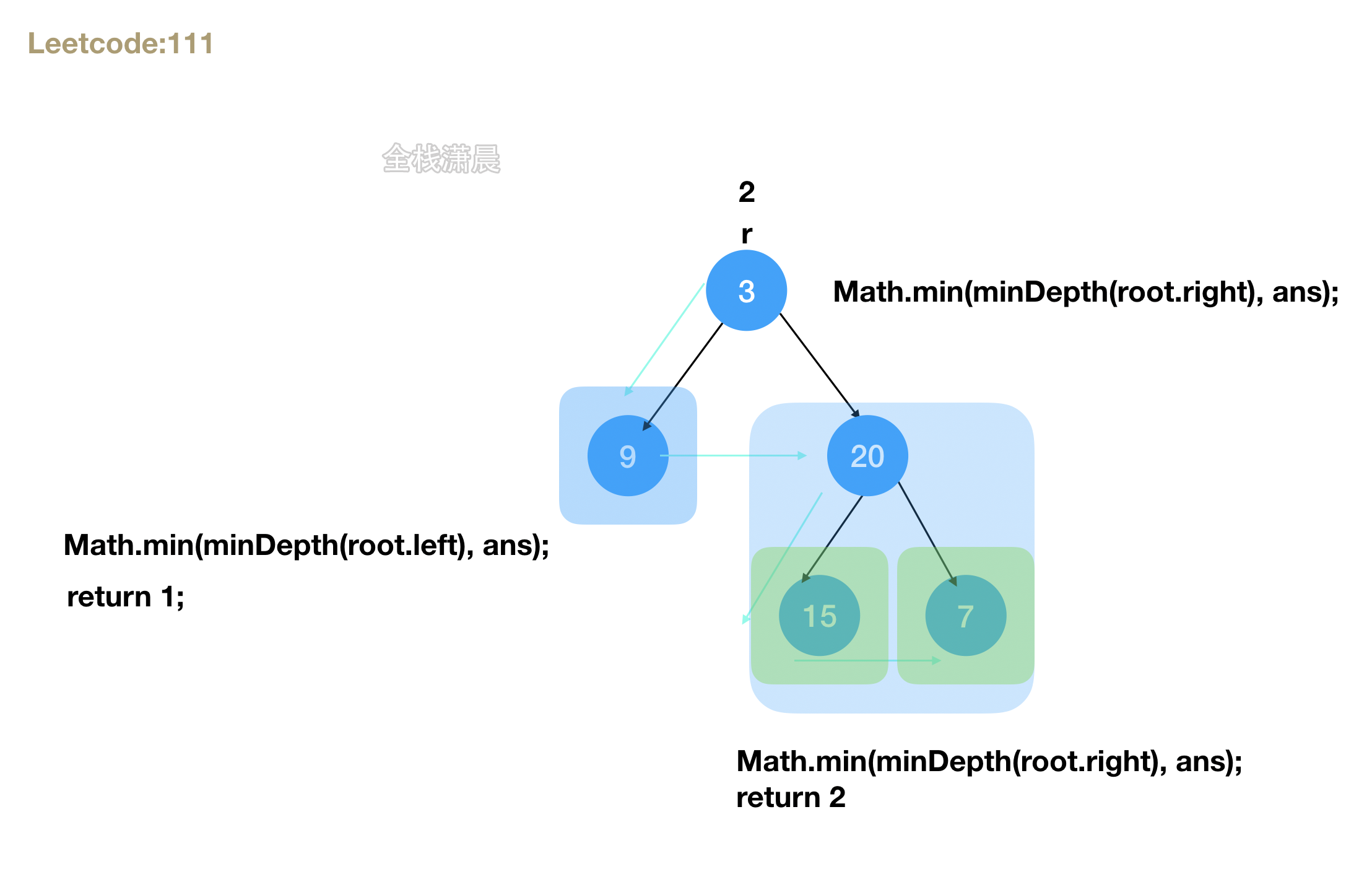
思路:深度优先遍历左右子树,分解成子问题,树的最小深度等于左右子树最小深度+1
复杂度分析:时间复杂度
O(n), 其中 n 为二叉树节点的个数。空间复杂度O(n), 其中 n 表示二叉树的高度,最坏的情况下树呈现链状,和树的节点数相同,平均情况下树的高度与节点数的对数正相关,空间复杂度为O(logn)
js:
var minDepth = function(root) { if(root == null) { return 0; } if(root.left == null && root.right == null) {//遍历到叶子结点终止 return 1; } let ans = Number.MAX_SAFE_INTEGER; if(root.left != null) { ans = Math.min(minDepth(root.left), ans);//递归左子树,找到左子树的最小深度 } if(root.right != null) { ans = Math.min(minDepth(root.right), ans);//递归右子树,找到右子树的最小深度 } return ans + 1;//最小深度等于左右子树最小深度+1};
Java:
class Solution { public int minDepth(TreeNode root) { if(root == null) { return 0; } if(root.left == null && root.right == null) { return 1; } int ans = Integer.MAX_VALUE; if(root.left != null) { ans = Math.min(minDepth(root.left), ans); } if(root.right != null) { ans = Math.min(minDepth(root.right), ans); } return ans + 1; }}
方法 2.bfs
思路:广度优先遍历二叉树,每一层深度+1,遇到第一个叶子结点终止,此时的深度就是最小深度
复杂度分析:时间复杂度
O(n),n 为二叉树的节点个数,每个节点只会被访问一次。空间复杂度O(n),表示队列中存放的元素,最坏情况下和二叉树节点个数一样
js:
var minDepth = function(root) { if(root == null) return 0; let q = [root]; //root本身就是一层,所以深度初始化为1 let depth = 1; while(q.length){ let len = q.length; for(let i=0; i<len; i++){ let curr = q.shift(); //判断是当前否是叶子节点 if(curr.left == null && curr.right == null){ return depth; } //如果不是叶子结点,就将其相邻节点加入队列 if(curr.left){ q.push(curr.left); } if(curr.right){ q.push(curr.right); } } depth++; } return depth;
};
Java:
class Solution { public int minDepth(TreeNode root) { if (root == null) { return 0; } int depth = 0; Queue<TreeNode> q = new LinkedList<>(); q.offer(root);
while (!q.isEmpty()) { int sz = q.size(); depth++; for (int i = 0; i < sz; i++) { TreeNode cur = q.poll(); if (cur.left == null && cur.right == null) { return depth; } if (cur.left != null) { q.offer(cur.left); } if (cur.right != null) { q.offer(cur.right); } } } return depth; }}
127. 单词接龙 (hard)
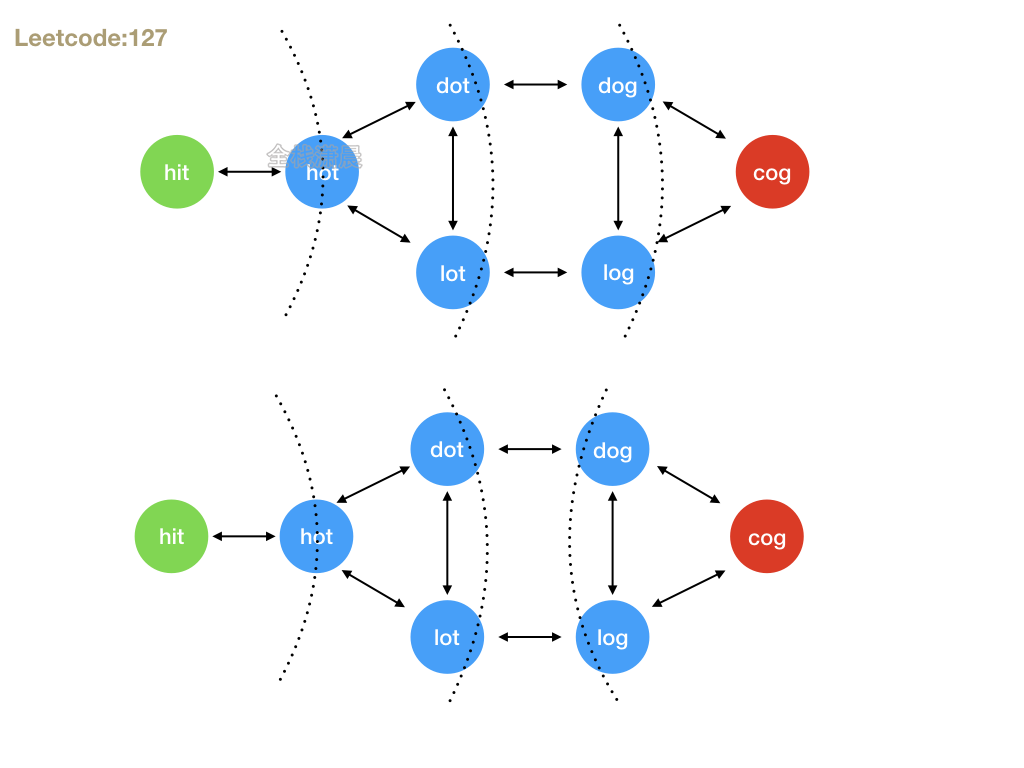
思路:bfs,循环 beginWord,对每个字符替换 26 个小写字符,看新生成的单词是否在 wordList 里面,如果存在就是一个合法的路径,直到新生成的单词是 endWord,循环完成还是没到达 endWord 就返回 0。双向 bfs 思路一样,只不过是从两边向中间靠拢,判断新生成的单词是否在另一个方向走过的路径中。
方法 1:bfs
js:
const ladderLength = (beginWord, endWord, wordList) => { const wordSet = new Set(wordList); const queue = []; queue.push([beginWord, 1]);//开始单词和层级加入队列
while (queue.length) { const [word, level] = queue.shift()//出队 进行bfs if (word == endWord) {//和endword相等返回层级 return level; } for (let i = 0; i < word.length; i++) { //循环单词列表 for (let c = 97; c <= 122; c++) { //循环26个小写字符 //得到新的单词 const newWord = word.slice(0, i) + String.fromCharCode(c) + word.slice(i + 1); if (wordSet.has(newWord)) { //检查wordset包不包括新生成的单词 避重复入列 queue.push([newWord, level + 1]); //新单词加入队列 wordSet.delete(newWord); //避死循环 } } } } return 0; // bfs结束,始终没有遇到终点};
方法 2:双向 bfs
js:
var ladderLength = function(beginWord, endWord, wordList) { let wordSet = new Set(wordList) if (!wordSet.has(endWord)) return 0 //从beginWord到endWord let begSet = [] //从endWord到beginWord let endSet = [] begSet.push(beginWord) endSet.push(endWord)
let n = 1//层级 while(begSet.length > 0){//开始遍历单词 const nextBegins = []//bfs下一层级的单词数组 //步数少数对换一下,让走的慢的在走几步 if(begSet.length > endSet.length){ let q = begSet begSet = endSet endSet = q } //循环begSet for(let k = 0; k < begSet.length;k++){ let m = begSet[k] for(let i = 0; i < m.length; i++){ for (let c = 97; c <= 122; c++){ //生成新词 let newm = m.slice(0, i) + String.fromCharCode(c) + m.slice(i + 1); if(endSet.includes(newm)){//相遇 return n + 1 } if( wordSet.has(newm)){ nextBegins.push(newm) //下一层bfs的单词数组 wordSet.delete(newm) //防止重复 } } } } begSet = nextBegins n++ //层级+1 } return 0 };
297. 二叉树的序列化与反序列化 (hard)
方法 1.递归 dfs
<img src="https://gitee.com/xiaochen1024/assets/raw/master/assets/20211118160722.png" alt="ds_110" style="zoom:50%;" />
思路:深度优先遍历,按根,左,右 返回字符串,方便反序列化的时候从根节点开始构建,递归左右子树,直到遇见了 null 节点。
复杂度:时间复杂度
O(n),每个节点访问一次,n 是树的节点个数。空间复杂度O(n),最坏情况下递归深度是 n
js:
const serialize = (root) => { if (root == null) { //遇到null 返回‘X’进行标示 return 'X'; } const left = serialize(root.left); //序列化左子树 const right = serialize(root.right); //序列化右子树 return root.val + ',' + left + ',' + right; //按根,左,右 返回字符串};
const deserialize = (data) => { const list = data.split(','); //字符串转数组
const buildTree = (list) => { //构建树 const rootVal = list.shift(); //第一个元素 if (rootVal == "X") { //如果是X,返回null return null; } const root = new TreeNode(rootVal); //如果不是X就创建节点 root.left = buildTree(list); //构建左子树 root.right = buildTree(list); //构建右子树 return root; //返回构建的节点 };
return buildTree(list);};
方法 2:bfs
思路:广度优先遍历节点,不断子节点不断入队,按照根左右的顺序序列化和反序列化
复杂度:时间复杂度
O(n),每个节点访问一次,n 是树的节点个数。空间复杂度O(n),队列的空间
js:
const serialize = (root) => { const queue = [root]; let res = []; while (queue.length) { const node = queue.shift(); //出队 if (node) { //node存在 推入根左右 res.push(node.val); queue.push(node.left); queue.push(node.right); } else { //如果不存在 推入‘x’ res.push('X'); } } return res.join(','); //数组转成字符串}
const deserialize = (data) => { if (data == 'X') return null;
const list = data.split(','); //字符串转数组
const root = new TreeNode(list[0]); //从队首开始构建 const queue = [root]; //根节点加入队列 let cursor = 1; //遍历到了第几个节点
while (cursor < list.length) { //当队列没遍历完时 const node = queue.shift(); //出队
const leftVal = list[cursor]; //左节点的值 const rightVal = list[cursor + 1]; //右节点的值
if (leftVal != 'X') { //不是空节点 const leftNode = new TreeNode(leftVal); //构建左节点 node.left = leftNode; //左节点挂在父节点的left下 queue.push(leftNode); //自己入列 构建以自己为根的子树 } if (rightVal != 'X') { const rightNode = new TreeNode(rightVal); node.right = rightNode; queue.push(rightNode); } cursor += 2; //构建的节点数+2 } return root; //返回根};
226. 翻转二叉树 (easy)
方法 1:递归
思路:递归左右子树,反转左右节点
复杂度:时间复杂度
O(n),树的每个节点都会遍历一遍。空间复杂度O(n),递归栈空间,最坏的情况下,和节点的个数 n 相同
js:
var invertTree = function(root) { if (root === null) {//递归终止条件 return null; } const left = invertTree(root.left);//递归左子树 const right = invertTree(root.right);//递归右子树 //交换左右节点 root.left = right; root.right = left; return root;};
java:
class Solution { public TreeNode invertTree(TreeNode root) { if (root == null) { return null; } TreeNode left = invertTree(root.left); TreeNode right = invertTree(root.right); root.left = right; root.right = left; return root; }}
100. 相同的树(easy)
方法 1.dfs 递归
思路:递归比较左右子树
复杂度:时间复杂度
O(n),n 是节点较少的树中的节点个数,递归有一个节点为 null,另一个不为 null 就停止递归,空间复杂度O(n),递归深度不会超过节点个数
js:
var isSameTree = function(p, q) { if(p == null && q == null) //都是null表示相同 return true; if(p == null || q == null) //只有一个是null表示不同 return false; if(p.val != q.val) //节点的值不同 return false; return isSameTree(p.left, q.left) && isSameTree(p.right, q.right);//递归左右子树};
java:
class Solution { public boolean isSameTree(TreeNode p, TreeNode q) { if(p == null && q == null) return true; if(p == null || q == null) return false; if(p.val != q.val) return false; return isSameTree(p.left, q.left) && isSameTree(p.right, q.right); }}
方法 2bfs:
复杂度:时间复杂度
O(n),n 是节点较少的树中的节点个数,空间复杂度O(n),队列的空间不会超过节点较少的树中的节点个数
js:
var isSameTree = function(p, q) { let pQ = [p], qQ = [q], res = true
while (pQ.length) { pNode = pQ.shift() qNode = qQ.shift()
if (pNode === null && qNode === null) { res = true } else if (pNode === null || qNode === null) { res = false break } else { if (pNode.val !== qNode.val) { res = false break } else { pQ.push(pNode.left) pQ.push(pNode.right)
qQ.push(qNode.left) qQ.push(qNode.right) } } }
return res};
java:
class Solution { public boolean isSameTree(TreeNode p, TreeNode q) { Queue<TreeNode> pQ = new LinkedList<TreeNode>(); Queue<TreeNode> qQ = new LinkedList<TreeNode>(); pQ.offer(p); qQ.offer(q); boolean res = true;
while (!pQ.isEmpty()) { TreeNode pNode = pQ.poll(); TreeNode qNode = qQ.poll();
if (pNode == null && qNode == null) { res = true; } else if (pNode == null || qNode == null) { res = false; break ; } else { if (pNode.val != qNode.val) { res = false; break ; } else { pQ.offer(pNode.left); pQ.offer(pNode.right);
qQ.offer(qNode.left); qQ.offer(qNode.right); } } } return res; }}
101. 对称二叉树 (easy)
方法 1.dfs 递归
复杂度:时间复杂度
O(n),每个节点遍历一次,空间复杂度O(n),递归栈深度,最深不超过 n
js:
var isSymmetric = function(root) { if(!root) return true const isMirror = (l, r) => { if(!l && !r) return true; //两个空节点也为镜像 if( l && r && l.val === r.val && //左节点和右节点相同,左子树和右子树也对称则返回true isMirror(l.left, r.right) && isMirror(l.right, r.left) ) { return true; } return false; } return isMirror(root.left, root.right)};
java:
class Solution { public boolean isSymmetric(TreeNode root) { return isMirror(root, root); }
public boolean isMirror(TreeNode l, TreeNode r) { if (l == null && r == null) { return true; } if (l == null || r == null) { return false; } return l.val == r.val && isMirror(l.left, r.right) && isMirror(l.right, r.left); }}
方法 2.bfs
复杂度:时间复杂度
O(n),每个节点遍历一次,空间复杂度O(n),队列的空间
js:
function isSymmetric(root) { const isMirror = (l, r) => { const queue = [l, r]; while (queue.length) { const u = queue.shift(); const v = queue.shift(); if (!u && !v) continue; //两个空节点也为镜像 //左右节点只有一个节点为空,或者值不相同返回false if (!u || !v || u.val !== v.val) return false; queue.push(u.left, v.right); //加入左节点的左子树,右节点的右子树 queue.push(v.left, u.right); //加入右节点的左子树,左节点的右子树 } return true; }; return isMirror(root.left, root.right);}
java:
class Solution { public boolean isSymmetric(TreeNode root) { return isMirror(root, root); }
public boolean isMirror(TreeNode u, TreeNode v) { Queue<TreeNode> queue = new LinkedList<TreeNode>(); queue.offer(u); queue.offer(v); while (!queue.isEmpty()) { u = queue.poll(); v = queue.poll(); if (u == null && v == null) { continue; } if ((u == null || v == null) || (u.val != v.val)) { return false; }
queue.offer(u.left); queue.offer(v.right);
queue.offer(u.right); queue.offer(v.left); } return true; }}
112. 路径总和 (easy)
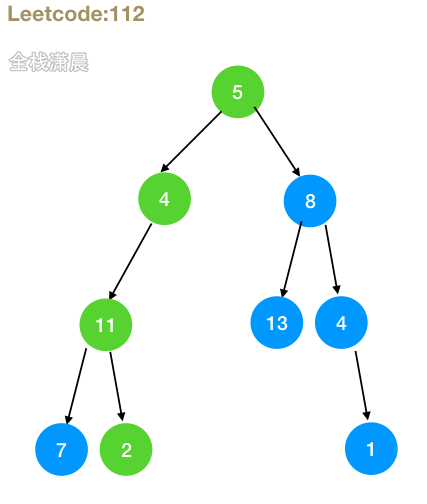
思路:递归左右子树,不断让 sum 减去当前节点的值。左右子树有一个返回 true 就找到了一条这样的路径
复杂度:时间复杂度
O(n),n 是节点个数,每个节点遍历一次。空间复杂度O(n),取决于递归栈空间,最坏的情况下是O(n)
js:
const hasPathSum = (root, sum) => { if (root == null) {//递归终止条件 return false; } if (root.left == null && root.right == null) {//遍历到叶子节点 return sum - root.val == 0; //sum正好减少到了0 返回ture 否则返回false } //递归左右子树,有一个返回true就找到了一条这样的路径 return hasPathSum(root.left, sum - root.val) || hasPathSum(root.right, sum - root.val);}
java:
class Solution { public boolean hasPathSum(TreeNode root, int sum) { if (root == null) { return false; } if (root.left == null && root.right == null) { return sum == root.val; } return hasPathSum(root.left, sum - root.val) || hasPathSum(root.right, sum - root.val); }}
437. 路径总和 III (medium)
方法 1:dfs
思路:递归左右子树,在递归的子阶段中,继续以该节点为根节点继续进行路径的寻找
复杂度:时间复杂度
O(n^2),所有节点都要遍历一边,还要寻找以该节点为根的子树中是否存在符合条件的路径。空间复杂度O(n),递归空间
js:
var pathSum = function(root, targetSum) { if (root == null) { return 0; } let ret = rootSum(root, targetSum);//以root为根节点的树中寻找路径 ret += pathSum(root.left, targetSum);//递归左子树,在左子树中寻找路径 ret += pathSum(root.right, targetSum);//递归右子树,在左子树中寻找路径 return ret;};
const rootSum = (root, targetSum) => { let ret = 0;
if (root == null) { return 0; } const val = root.val; if (val === targetSum) { ret++; }
//以root.left为根节点,targetSum - val为寻找的路径和,继续寻找路径 ret += rootSum(root.left, targetSum - val); //以root.right为根节点,targetSum - val为寻找的路径和,继续寻找路径 ret += rootSum(root.right, targetSum - val); return ret;}
java:
class Solution { public int pathSum(TreeNode root, int targetSum) { if (root == null) { return 0; }
int ret = rootSum(root, targetSum); ret += pathSum(root.left, targetSum); ret += pathSum(root.right, targetSum); return ret; }
public int rootSum(TreeNode root, int targetSum) { int ret = 0;
if (root == null) { return 0; } int val = root.val; if (val == targetSum) { ret++; }
ret += rootSum(root.left, targetSum - val); ret += rootSum(root.right, targetSum - val); return ret; }}
方法 2:前缀和
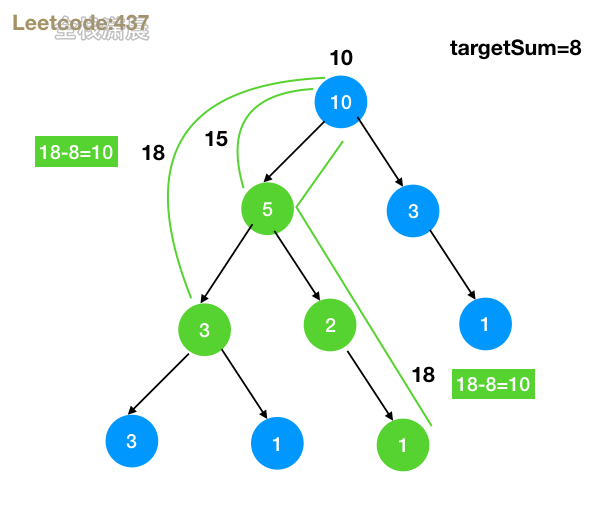
思路:记录从根节点到该节点的路径和 curr,在递归左右子树,看之前遍历过的路径中是否存在以
curr - targetSum为 路径和的路径,如果存在,那么从根节点到当前节点的路径 减去 这条路径 就是符合条件的路径之一,看图复杂度:时间复杂度
O(n),二叉树中的节点只遍历一遍。空间复杂度O(n),递归栈深度。
js:
var pathSum = function(root, targetSum) { const prefix = new Map();//存放前缀和 和它的路径数量 prefix.set(0, 1);//初始化前缀和是0的个数 return dfs(root, prefix, 0, targetSum);}
const dfs = (root, prefix, curr, targetSum) => {//curr指到达当前节点的路径上的和 if (root == null) {//空节点就没有路径了,返回0 return 0; }
let ret = 0; curr += root.val;//加上当前节点
ret = prefix.get(curr - targetSum) || 0;//获取以curr - targetSum的前缀和的数量 prefix.set(curr, (prefix.get(curr) || 0) + 1);//在prefix中增加curr的前缀和的数量 ret += dfs(root.left, prefix, curr, targetSum);//递归左子树 加上左子树前缀和为targetSum的路径数 ret += dfs(root.right, prefix, curr, targetSum);//递归右子树 加上右子树前缀和为targetSum的路径数 prefix.set(curr, (prefix.get(curr) || 0) - 1);//节点递归完毕,回溯curr的前缀和数量 避免重复计算
return ret;}
java:
class Solution { public int pathSum(TreeNode root, int targetSum) { HashMap<Long, Integer> prefix = new HashMap<>(); prefix.put(0L, 1); return dfs(root, prefix, 0, targetSum); }
public int dfs(TreeNode root, Map<Long, Integer> prefix, long curr, int targetSum) { if (root == null) { return 0; }
int ret = 0; curr += root.val;
ret = prefix.getOrDefault(curr - targetSum, 0); prefix.put(curr, prefix.getOrDefault(curr, 0) + 1); ret += dfs(root.left, prefix, curr, targetSum); ret += dfs(root.right, prefix, curr, targetSum); prefix.put(curr, prefix.getOrDefault(curr, 0) - 1);
return ret; }}
257. 二叉树的所有路径 (easy)
方法 1:dfs
思路:递归左右子树,直到叶子节点,递归的过程中不断透传 path,递归的每一层连接上当前节点的值
复杂度:时间复杂度
O(n),每个节点遍历一次。空间复杂度O(n),递归栈空间
js:
var binaryTreePaths = function(root) { const paths = []; const dfs = (root, path) => {//传入递归的节点和路径数组 if (root) { path += root.val.toString();//加入当前节点 //叶子结点就将所有连接起来的节点字符串加入paths中 也就是其中一条路径 if (root.left === null && root.right === null) { paths.push(path); } else { path += "->"; //不是叶子节点继续递归左右子树 dfs(root.left, path); dfs(root.right, path); } } } dfs(root, ""); return paths;};
java:
class Solution { public List<String> binaryTreePaths(TreeNode root) { List<String> paths = new ArrayList<String>(); dfs(root, "", paths); return paths; }
public void dfs(TreeNode root, String path, List<String> paths) { if (root != null) { StringBuffer path1 = new StringBuffer(path); path1.append(Integer.toString(root.val)); if (root.left == null && root.right == null) { paths.add(path1.toString()); } else { path1.append("->"); dfs(root.left, path1.toString(), paths); dfs(root.right, path1.toString(), paths); } } }}
方法 2:bfs
思路:用队列辅助进行广度优先遍历,不断将左右子节点加入队列,直到叶子节点
复杂度:同方法 1
js:
var binaryTreePaths = function(root) { const res = []; if (root === null) { return res; } const nodes = [root]; const paths = [root.val.toString()];
while (nodes.length) { const node = nodes.shift(); const path = paths.shift();
if (node.left === null && node.right === null) {//叶子节点 res.push(path); } else { if (node.left !== null) {//左节点不为空 加入队列 nodes.push(node.left); paths.push(path + "->" + node.left.val.toString()); }
if (node.right !== null) {//右节点不为空 加入队列 nodes.push(node.right); paths.push(path + "->" + node.right.val.toString()); } } } return res;};
java:
class Solution { public List<String> binaryTreePaths(TreeNode root) { List<String> res = new ArrayList<String>(); if (root == null) { return res; } Queue<TreeNode> nodeQueue = new LinkedList<TreeNode>(); Queue<String> pathQueue = new LinkedList<String>();
nodeQueue.offer(root); pathQueue.offer(Integer.toString(root.val));
while (!nodeQueue.isEmpty()) { TreeNode node = nodeQueue.poll(); String path = pathQueue.poll();
if (node.left == null && node.right == null) { res.add(path); } else { if (node.left != null) { nodeQueue.offer(node.left); pathQueue.offer(new StringBuffer(path).append("->").append(node.left.val).toString()); }
if (node.right != null) { nodeQueue.offer(node.right); pathQueue.offer(new StringBuffer(path).append("->").append(node.right.val).toString()); } } } return res; }}
199. 二叉树的右视图 (medium)
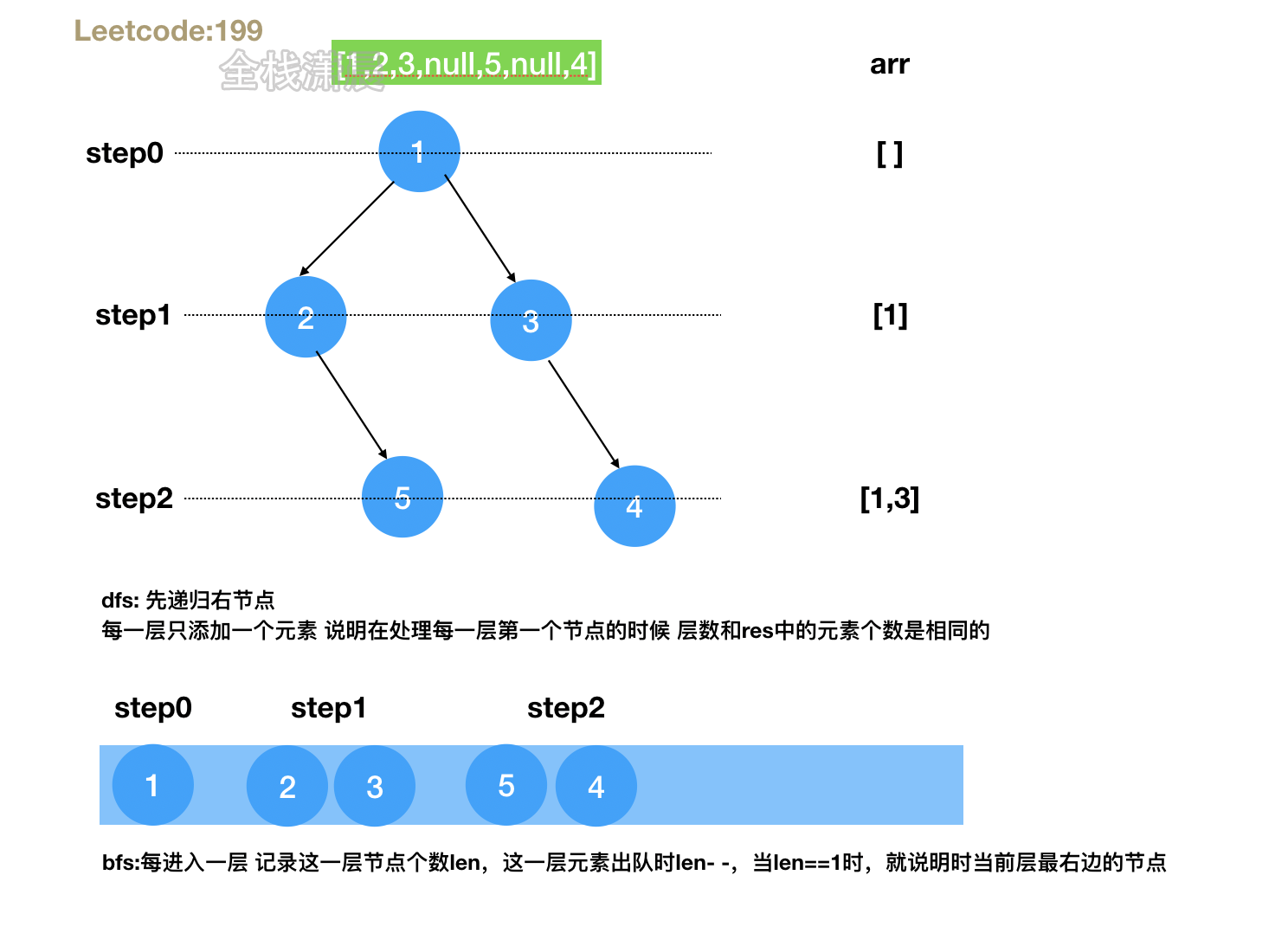
方法 1:dfs
思路:深度优先遍历,先递归右节点 让它在下一层先被处理,当 res 长度和 step 相等时 当前节点就是这一层的右节点,加入数组中
复杂度:时间复杂度
O(n),每个节点遍历一次。空间复杂度O(n),递归栈空间
js:
var rightSideView = function (root) { function dfs(root, step, res) {//传入根节点 层数 右视的节点的数组 if (root) { if (res.length === step) { res.push(root.val); //当res长度和step相等时 当前节点就是这一层的右节点 加入数组中 } dfs(root.right, step + 1, res); //先递归右节点 让它在下一层先被处理 dfs(root.left, step + 1, res); } } if (!root) return []; let arr = []; dfs(root, 0, arr); return arr;};
java:
class Solution { List<Integer> res; public List<Integer> rightSideView(TreeNode root) { res = new LinkedList<>(); if (root == null) { return res; } dfs(root, 0); return res; }
private void dfs(TreeNode root, int depth) { if (root == null) { return; } if (depth == res.size()) { res.add(root.val); } dfs(root.right, depth+1); dfs(root.left, depth+1); }}
方法 2:bfs
思路:广度优先遍历,记录每一层的节点个数,出队之后让长度减 1,当当前层长度等于 1 时 说明是最边的节点。
复杂度:时间复杂度
O(n),每个节点遍历一次。空间复杂度O(n),队列的空间
js:
var rightSideView = function (root) { if (!root) return []; let queue = [root]; //广度优先遍历的队列 首先加入root let arr = []; //存放右视的节点 while (queue.length > 0) { let len = queue.length; while (len) { let node = queue.shift(); //取出队列第一个元素 if (len === 1) arr.push(node.val); //当当前层长度等于1时 说明是最边的节点 if (node.left) queue.push(node.left); //继续向队列中添加左右节点 if (node.right) queue.push(node.right); len--;//出队之后 当前层长度减1 } } return arr;};
java:
class Solution { public List<Integer> rightSideView(TreeNode root) { List<Integer> res = new LinkedList<>(); if (root == null) { return res; } Queue<TreeNode> queue = new LinkedList<>(); queue.offer(root); while (!queue.isEmpty()) { int size = queue.size(); TreeNode curr = null; for (int i = 0; i < size; ++i) { curr = queue.poll(); if (curr.left != null) { queue.offer(curr.left); } if (curr.right != null) { queue.offer(curr.right); } } res.add(curr.val);//或者在换一种思路,循环完当前层之后,最后出队的就是当前层最右边的一个 } return res; }}
全栈潇晨
还未添加个人签名 2021.02.17 加入
还未添加个人简介












评论